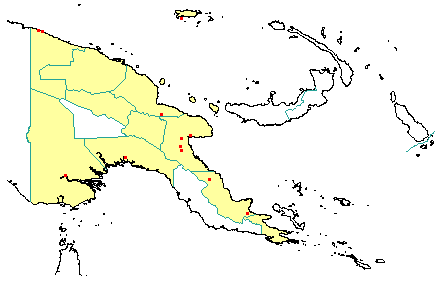
in PNGplants database
PNGTreesKey – Aglaia argentea Blume |
Barry Conn (NSW) & Kipiro Damas (LAE).
Guide to trees of Papua New Guinea
Copyright held by the authors, National Herbarium of New South Wales, and Papua New Guinea National Herbarium
Flora van Nederlandsch Indië Vol. 4: 170 (1825)
Other Literature: C.M. Pannell, Flora Malesiana, Series 1 237-238 (1995)
Family: Meliaceae
Dicotyledon
Timber Group: Occasional timber species
Field Characters: Large canopy tree (up to 25 m high) or Small sub-canopy tree; Bole cylindrical (30-60 cm diam.); straight (up to 18 m long); buttresses buttresses present (buttresses up to c. 1 m high) or buttresses absent; spines spines absent; aerial roots aerial roots absent; stilt roots stilt roots absent; Bark grey or brown, slightly rough or smooth, slightly pustular, lenticels elongated vertically; less than 25 mm thick, 10.0 (c.); bark blaze consisting of one layer; faintly to non-aromatic; outer blaze white, pale yellow, or pale brown, markings absent; inner blaze white, pale yellow, or pale brown, markings absent; bark exudate (sap) present, white/milky, flowing, colour not changing on exposure to air, sticky; terminal buds not enclosed by leaves.
Indumentum: Complex hairs present, star-like (stellate) (on branchlets, leaves, flowers and fruits); stinging hairs absent; mature twig indumentum (hairs) present, hairs dense.
Leaves: Leaves spaced along branches, spiral (leaves occurring singly at a node and arranged spirally up the branchlet), compound (a leaf made up from two or more leaflets); petiole present, not winged (although lamina very slightly decurrent), attached to base of leaf blade, not swollen; leaves pinnate (unbranched with more than three leaflets); petiolule not swollen or slightly swollen; rachis present, absent, absent; leaves with a terminal leaflet (the number of leaflets odd - imparipinnate), slightly broadest above middle or broadest at or near middle, 4.5-25.0 (-33.0) cm, 1.5-11.0 (-14.0) cm, sub-leaflets opposite or leaflets alternate, symmetric (to slightly asymmetric), terminal developing leaflet buds straight; venation pinnate, secondary veins open, prominent, intramarginal veins absent; leaves lower surface green or grey (slightly with rust-coloured peltate scales), upper surface green (dull peltate scales present), indumentum (hairs) present, indumentum (hairs) dense (peltate scales); absent; domatia absent; stipules absent.
Flowers: Inflorescence terminal or axillary, flowers on a branched axis (flowers with citronella-like odour), cones absent; flowers unisexual, unisexual with male and female flowers on different plants, stalked, flowers with many planes of symmetry, 2.0-4.0 mm long, diameter small (up to10 mm diam.) (1.5-2.5 mm diam.); perianth present, with distinct sepals and petals whorls, inner perianth white or yellow; 5, free or some or partly joined; stamens 5 (male flowers), present, joined (forming a staminal tube), free of the perianth; ovary superior (female flowers), carpels joined (when more than one), locules 2 (-3); styles absent or solitary (then very short), 0-1.
Fruits: Infrutescence arranged on branched axis, fruit 30.0-35.0 mm long, cream-coloured or grey, not spiny, fleshy, simple, indehiscent or slightly dehiscent, capsule; seeds 1-(0 or 1 per locule)-3, much more than 10 mm long (20-30 mm long), not winged, broad (as wide as long), seed more than 10 mm diam. (15-20 mm diam.).
Distribution: West Sepik, East Sepik, Madang, Morobe, Western Highlands, Eastern Highlands, Western, Gulf, Northern, Milne Bay & Manus.
 | Botanical records in PNGplants database |